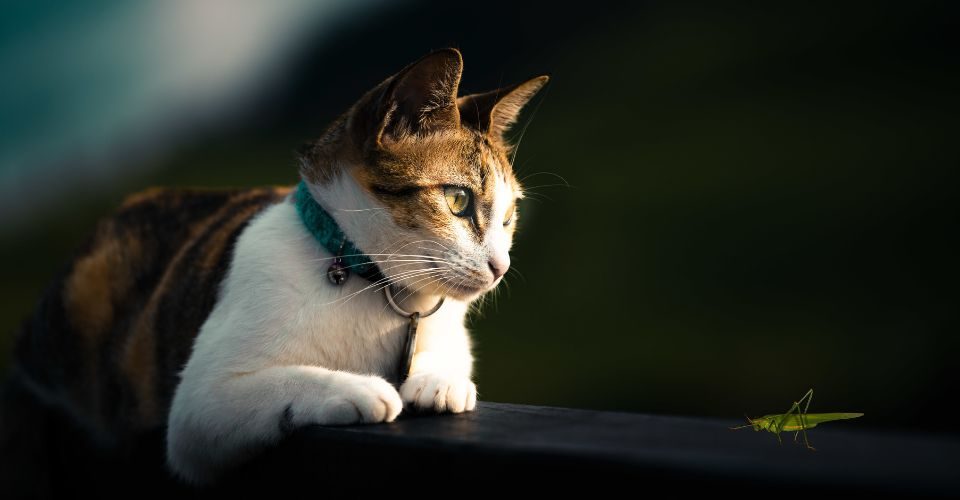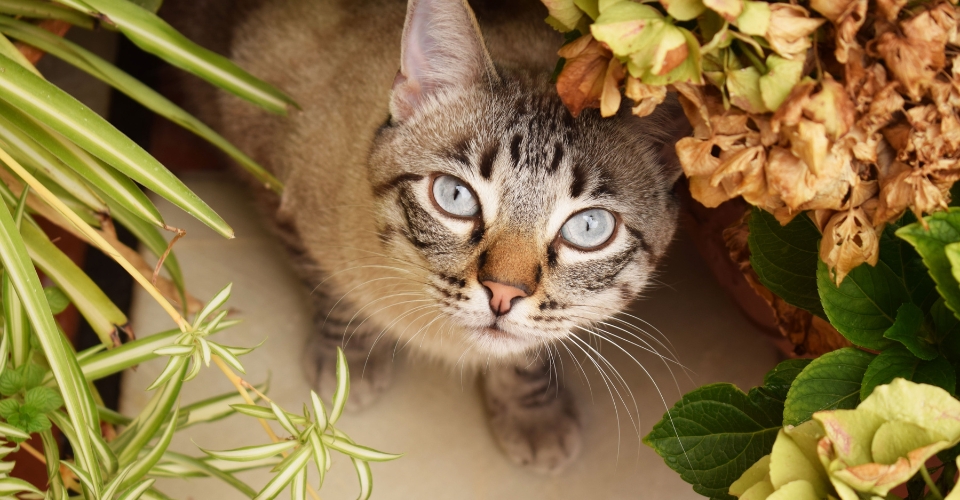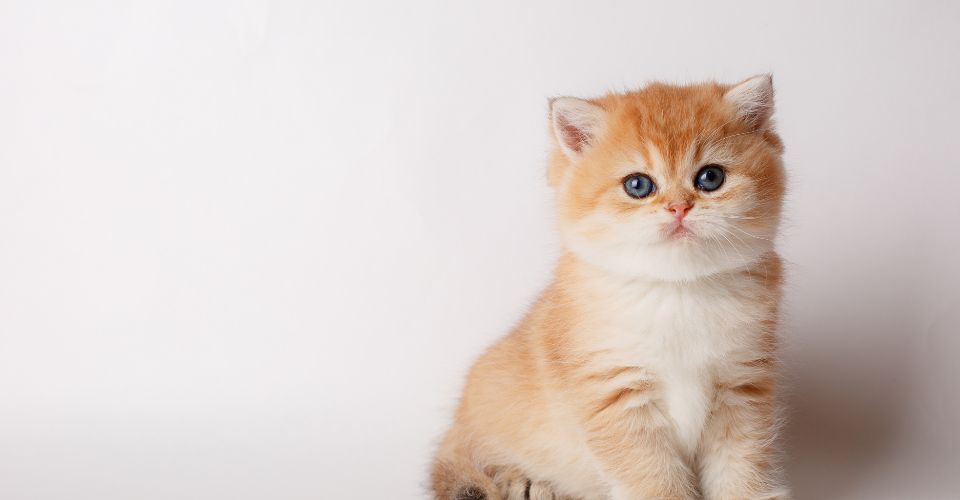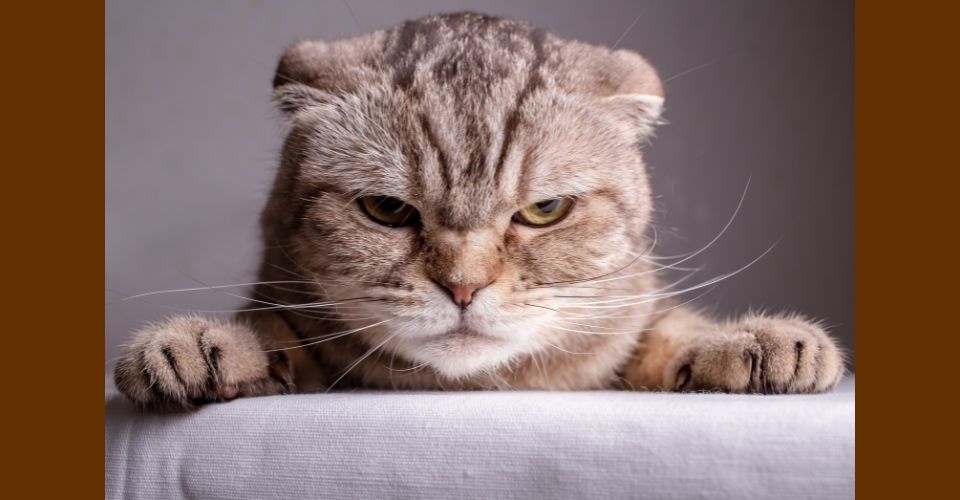With more than 6,000 types, katydids are a family related to grasshoppers and crickets that you might be able to spot on your lawn. Our curious cats are fascinated by these small, moving insects. They love to stalk them, chase them around, and paw them down. Cats are natural hunters, after all. After successfully catching the katydid, your cat may gobble it up. No true hunter leaves the hunt behind.
Bringing your cat out to play on the lawn, you may wonder: can cats eat katydids?
Yes, cats can eat katydids, just like they can eat crickets. Katydids are no different from crickets and would have a similar impact on felines’ digestive systems.
Can Cats Eat Katydid?
Yes, cats can eat katydid. Loaded with proteins, chitin, minerals, and vitamins, katydids actually make a healthy snack for cats. That said, their exoskeleton and the risk of pesticides and insecticides could severely jeopardize your kitty’s health. Therefore, you should keep a close eye on your cat when she is playing with a katydid.
Benefits of Cats Eating Katydid
1. Proteins
Katydids contain a lot of proteins, and since cats are carnivorous and need a lot of proteins in their diet, katydids make a great snack for cats. Some sources even claim that katydids contain more proteins than the regular meat diet in cats. Furthermore, unlike meat, these insects do not contain much harmful fat content.
Cats need proteins to fuel their daily activities. Besides, those are especially important for a good nervous system and to ensure timely hair growth.
2. Chitin
Thanks to the hard exoskeleton, katydids are full of chitin – a polysaccharide biomolecule – which has numerous benefits for pets. If consumed regularly, it may lead to the loss of weight, control of blood pressure and cholesterol, and proper digestion.
Chitin can be especially advantageous for cats with sensitive stomachs as it promotes the growth of good intestinal bacteria. In some cases, it may also get them rid of irritable bowel syndrome.
3. Vitamins
Katydids are rich in various useful vitamins. For instance, thiamine (vitamin B1) present in katydids, can help kitties maintain a healthy brain and metabolism. Similarly, vitamin B12 in these insects is essential to tough out a cat’s immunity, cognitive functions, nervous system, and digestive tract.
4. Minerals
Katydids contain a good amount of iron and calcium – higher than vitamins. Iron is important for cats suffering from anemia, whereas calcium plays a vital role in bone, teeth, muscle, and nervous system health.
Disadvantages of Cats Eating Katydid
a) Exoskeleton
The exoskeleton of katydids can make a two-pronged attack on your kitty’s well-being: by impacting dental and intestinal health. The exoskeleton can be hard to chew at and may cause dental injuries. Similarly, it can cause several stomach-related problems if your cat’s digestive system does not respond well to it.
However, note that only a few katydids might not create such problems. If your kitty has a lot of them, such complications might occur.
b) Pesticides and Insecticides
Perhaps the biggest threat felines face from eating wild katydids comes from pesticides and insecticides. These chemicals can, unfortunately, cause severe poisoning in cats. Since katydids are found over the crops, if they get pesticides or insecticides on their bodies during the spraying process, the chances of cats getting poisoned increase severely.
At first, a cat might experience seizures and disturbed breathing, but in serious poisoning, death may occur.
c) Parasites
Katydids might carry parasites like tapeworms in their stomachs. If eaten, such parasites are transferred into your cat’s stomach. However, they do not make any significant impact on the feline health except for diarrhea and vomiting, which clear up within a few days. But if it does not happen, vet assistance must be sought.
Read:
Getting Rid of Worms in Cats: 4 Best Dewormer for Cats
How Do Cats Get Worms? 3 Home Remedies for Worms in Cats
d) Bites
Katydids are among those insects that bite when they feel threatened. Nevertheless, katydid bites are not severe – they are more or less like mosquito bites. Most of the time, they are not even felt.
But they might redden cat skin where bitten temporarily and cause itchiness.
Do Cats Like Eating Katydids?
Yes, being carnivorous, cats have no qualms in eating different kinds of insects, including katydids, and may savor their taste too. Other than being a yummy six-legged piece of meat, katydids are popular in the feline world because of their quick motion. Having such moves, katydids catch cats’ attention very well due to their strong hunting instincts.
How to Keep Katydids Away From Your Cat?
If you do not want to take the risk of letting your cat have katydids, you can try out the following methods:
Use Spinosad
It is an organic substance made from soil bacteria. It causes hyperactivity of the nervous system in insects which can lead to paralysis and even death. Furthermore, it is an FDA-approved chemical that can be used as a pesticide but with almost no effect on humans and other mammals.
To achieve the desired results, make sure to remove the dead bodies of katydids so that your cat might not end up eating those.
Go For Light Traps
Like flies and mosquitoes, katydids are also attracted to light a lot. By using light trap killers – the same commonly used for houseflies – near the place where you suspect the presence of katydids in your home, you can reduce their population.
Growing Chrysanthemums
Certain plants, such as chrysanthemums, contain chemicals like pyrethrin that are poisonous to insects. When ingested, they can lead to paralysis and eventually death by severely harming the nervous system. But given that chrysanthemums are toxic to cats and dogs as well, we don’t recommend that you grow them in your garden, which your cat might have access to.
Growing such plants is a unique and environmentally friendly way of protecting your cat from katydids – mainly because you are contributing to a green neighborhood and not using any sort of harmful chemicals. But keep in mind that these plants are toxic for cats.
Typical Actions
Just destroy the habitat near your home where katydids thrive. Cut the grass and use chemical products to get rid of these itsy-bitsy critters. But make sure that you are using only pet-safe chemicals – you don’t want to cause more harm than good.
What to Do if Your Cat Goes Unwell After Having Katydid?
There are fairly low chances of cats having a big impact from eating katydids. Most of the time, the problems might show up after some days, especially if the parasitic infection is the culprit.
Therefore, if you know that your cat does eat katydids often, you should be watchful of her health. If any signs of sickness in cats show up, know that it is time to take your cat to a vet, as it could be difficult for you to know what exactly has gone wrong or what to do next.
Conclusion: Can Cats Eat Katydid?
Yes, cats can eat katydids. Being quite similar to crickets, katydids have the same – both positive and negative – impacts on felines. Where katydids are full of beneficial nutrients, they might also pose some problems due to some of their features, for instance, their hard exoskeleton.





